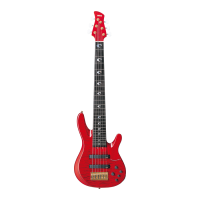
Do you have a question about the Yamaha TRB-JP2 and is the answer not in the manual?
| fingerboard material | Ebony |
|---|---|
| fingerboard width at 0 fret | 56.0 mm |
| fingerboard width at 12 fret | 81.1 mm |
| number of frets | 26 |
| neck material | Maple |
|---|---|
| neck thickness at 1 fret | 21.0 mm |
| neck thickness at 12 fret | 23.5 mm |
| volume control resistance | 5 KΩ |
|---|---|
| balancer control resistance | 20 KΩ |
| equalizer control resistance | 50 KΩ (BASS, MID, TREBLE) |
| scale length | 889.0 mm |
|---|---|
| length | 1200.0 mm |
| width | 353.0 mm |
| net weight | 5.2 kg |
| body depth | 43 mm |
Includes the neck, tuning machines, nut, bushings, strap buttons, and associated screws.
Covers the guitar body, bridge system, base, and piece assemblies.
Lists circuit board, battery box, jack, panel, pickups, and wiring hardware.
Details included accessories like cords, wrenches, battery, and the hard case.
Detailed list of various capacitors and carbon/metal film resistors used in the circuitry.
Identification of diodes, transistors, and integrated circuits for signal processing.
Lists connectors for inputs/outputs, inductors, and field-effect transistors.
Potentiometers for volume and equalizer controls (Bass, Mid, Treble).
Diagram showing the location of components on the circuit board (Component side).
Diagram illustrating the printed circuit board layout (Pattern side).
Detailed schematic diagram of the guitar's electronic circuitry.
Key for identifying capacitors, resistors, and other electronic components.
Diagram illustrating the internal wiring connections for pickups, controls, and output.
Details scale length, body-neck construction, overall dimensions, and weight.
Information on body, neck, fingerboard materials and color finishes.
Specifications for hardware parts like nut, bridge, pickups, and control functions.
Important safety notice regarding lead in solder and other chemical content.
